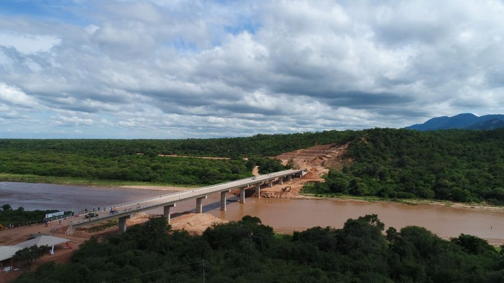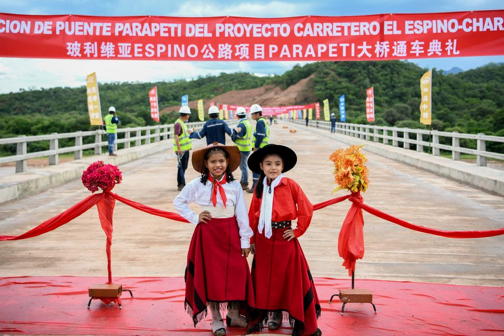
Click here or on above picture to see video in ORIGINAL ARTICLE.
Xinhua Headlines: New bridge fast tracks life of indigenous population in Bolivia
February 8, 2020- Original article: www.Xinhuanet.com
The construction of the new bridge has demonstrated that modernity can come to distant and isolated places while at the same time showing respect for indigenous lands, identity, and the environment.
by Xinhua writers Cui Yuanlei, Yang Chunxue, Pei Jianrong
LA PAZ, Feb. 8 (Xinhua) -- The Guarani people, an indigenous group living in Bolivia's southern lowlands, have long had the dream of enjoying modern bridges and highways.
Now, their dream has become reality.
After more than a year of hard work, the 306-meter-long Parapeti Bridge, whose construction was led by the China Railway Group Limited (CREC), was inaugurated on Friday.
(below) Photo taken on Feb. 7, 2020 shows the opening ceremony of the Parapeti Bridge on the under-construction El Espino-Charagua-Boyuibe Highway in Santa Cruz, Bolivia. (Xinhua/Xin Yuewei)

IMPROVED INFRASTRUCTURE
Before the construction of the Parapeti Bridge, the locals had to use an old small bridge that connected various Guarani communities in the area. Safety issues had troubled many for decades.
Now, running parallel to the old bridge, the new Parapeti Bridge over the Parapeti River boasts wider roads and a sturdier construction, said Mario Perez, an engineer and a bridge specialist.
Head Chief of the Guarani communities in the area, Eugenio Vitingay, said that the Parapeti Bridge will replace the old one that had been an essential part of local infrastructure.
"The most dangerous thing was to cross the old bridge, and now we feel safer with the new bridge," Vitingay said.
(below) A car runs on the old bridge in Santa Cruz, Bolivia, Feb. 6, 2020. (Xinhua/Xin Yuewei)

Speaking at the inauguration ceremony of the new bridge, Chinese Ambassador to Bolivia Huang Yazhong said that the bridge symbolizes the friendship between the peoples of China and Bolivia.
"With the completion of the bridge, the local people can now cross the Parapeti River at ease and from now on, they no longer have to walk on the unsafe and unsustainable bridges that involve high risks," Huang added.
The Parapeti Bridge is one of the four longest bridges of the El Espino-Charagua-Boyuibe Highway project, a flagship project within the framework of the China-proposed Belt and Road Initiative (BRI).
Now nearly 50 percent completed, according to the Bolivian Highway Administration (ABC), the 160-km El Espino-Charagua-Boyuibe Highway will directly link the country's eastern departments of Santa Cruz, Chuquisaca and Tarija with each other and with neighboring Paraguay and Argentina.
(below) Aerial photo taken on Feb. 6, 2020 shows the Parapeti Bridge on the under-construction El Espino-Charagua-Boyuibe Highway in Santa Cruz, Bolivia. (Xinhua/Xin Yuewei)

DREAM COMES TRUE
"We have always wished, as an indigenous area, for highways and modern bridges," Salomon Torrez, head of the local San Antonio community, told Xinhua.
"We are happy that this project of great magnitude and this modern bridge pass right through our area, because it will help our impoverished people get better," said Torrez.
For Vitingay, the construction of the new bridge has demonstrated that modernity can come to distant and isolated places while at the same time showing respect for indigenous lands, identity, and the environment.
The indigenous coordinator between CREC and the community of Ipitakuape, Juan Pinto, said that the bridge is very important for local inhabitants, not only as a means of transportation, but also because 85 percent of the labor for the project was drawn from the local population.
"The dream has been fulfilled," said Pinto.
(below) Local kids pose for a group photo at the opening ceremony of the Parapeti Bridge on the under-construction El Espino-Charagua-Boyuibe Highway in Santa Cruz, Bolivia, Feb. 7, 2020. (Xinhua/Xin Yuewei)

According to Enrique Concepcion, the ABC's regional manager for Santa Cruz, the highway is a high-impact infrastructure project that has brought benefits to communities along the route by hiring local workers.
The CREC will also lead the construction of two other bridges in Saipuru and Cuevo, both in the Santa Cruz department. The bridges will also make up part of the El Espino-Charagua-Boyuibe Highway project.
BENEFITING PEOPLE
Juan Pablo Saucedo, an economist and professor at Nur University of Bolivia, said that infrastructure is one of Bolivia's weakest areas and that China is a crucial partner in improving Bolivia's infrastructure.
"The development of infrastructure is very important for Bolivia at all levels," he said, adding that the highway is a way of providing access to centers of production and generating direct and indirect employment.
Saucedo believed that the BRI allows countries to diversify trade and to increase investment, tourism, and cultural exchanges through infrastructure building.
He said the idea is welcomed and shared by cooperation partners under the framework.
(below) Aerial photo taken on Feb. 6, 2020 shows the old bridge (top) and the Parapeti Bridge on the under-construction El Espino-Charagua-Boyuibe Highway in Santa Cruz, Bolivia. (Xinhua/Xin Yuewei)

As to CREC's efforts to preserve the environment and the approximately 30 indigenous communities living near the highway zone, Saucedo said that investment partners must take the issue of preservation into account and the preservation efforts by the Chinese company should be commended.
According to the ABC, the highway project, which runs through a productive agricultural area, is being carried out using up-to-date environmental standards in order to limit its impact on the environment.
As an international public good based on mutual respect and win-win cooperation, the BRI is a welcome formula for Latin America.
So far, Chinese companies have undertaken 20 highway projects throughout Bolivia with a total of more than 1,500 kilometers, which can not only improve Bolivia's transportation infrastructure and connectivity in all regions, but also the living standards and economic and social benefits of the people. ?
(Video reporters: Pei Jianrong, Wu Hao, Kang Wenjun; Video editor: Ma Ruxuan)